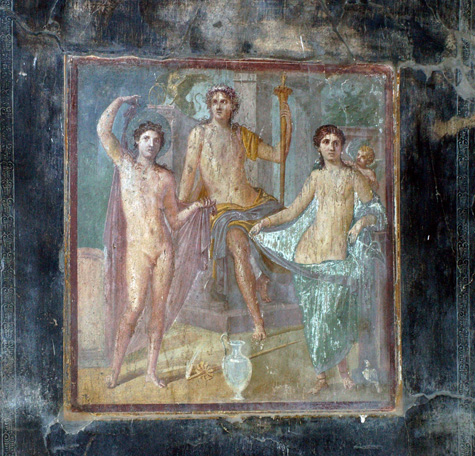
The domus – security, prosperity, status
In contrast to the inward orientation that provided security, houses were also expected to act as outward symbols of the owners social standing as well as that of his ancestors. In Roman society lineage played a substantial part in determining your status and your potential for social advancement. Since patronage was at the centre of Roman society, the patronus used his house as a place in which to conduct his daily meetings and as a vehicle for enhancing his social and political standing in society. He was central to the life of the domus, a term used to signify the extended family of blood relatives and servants that inhabited the houses of wealthier citizens. Clients were usually restricted to the public areas such as the fauces and atrium, whilst special guests were invited to enter private areas and family members roamed according to rank and status. The wall-paintings provided the visual backdrop for this complex mixture of business and domesticity that resonated with the concerns, feelings and emotions that constituted the domus.
The numerous small houses in Pompeii indicate that the majority of property owners must have been clients within the domus – patronus or elite-client model. In recent years, however, much of the literature on the wall-paintings focused on the elite, with the result that subject-matter and pictorial iconography was skewed in favour of emphasising their value purely as status signifiers. Two examples of this approach are Zanker, P., 1998, Pompeii: public and private life ; and Leach, E.W., 2004, The Social Life of Painting in Ancient Rome and on the Bay of Naples.
[see also the Bryn Mawr Classical Review of this publication by Elsner, J., 2004,12.33 http://ccat.sas.upenn.edu/bmcr/2004/2004-12-33.html ]
Composition and Context
Domestically located wall-painting by definition involves a dynamic relationship between composition and environment and this makes it more than the sum of its parts. At the same time it contributed to, and was affected by, many other factors that made up the physical and social environment in which it existed. Hence, referring to it as ‘domestically located’ wall-painting, whilst factually correct can also be misleading, because the word ‘domestic’ now signifies a clear demarcation between workplace and home. Unlike most contemporary houses, the Roman domus, as several writers have pointed out, consisted of a mixture of public and private spaces. This made it an environment that facilitated a broad range of familial, social and commercial interactions and the wall-paintings were woven into this physical and social matrix. The unqualified use of the word ‘domestic’ in connection with the Roman house and its wall-paintings has undoubtedly skewed our understanding of the paintings. Particularly if we bear in mind that by the mid-nineteenth century the drawing rooms of high society Europe were already full of appropriated forms of Pompeian painting, placed there for purely decorative purposes. [For more on the theme of domestic space and the Roman house see Laurence, R. and Wallace-Hadrill, A., 1997, Domestic Space in the Roman World Pompeii and Beyond, JRA Supplement 22; and Hales, S., 2003, The Roman House and Social Identity.]
|